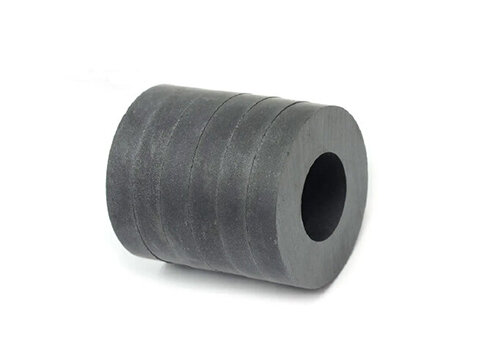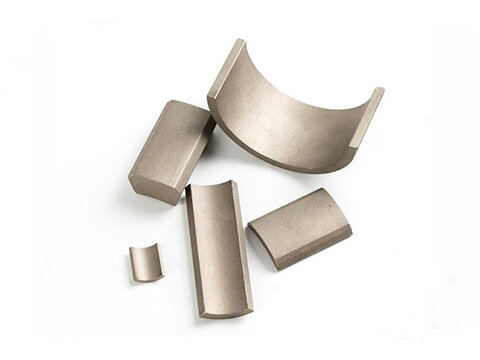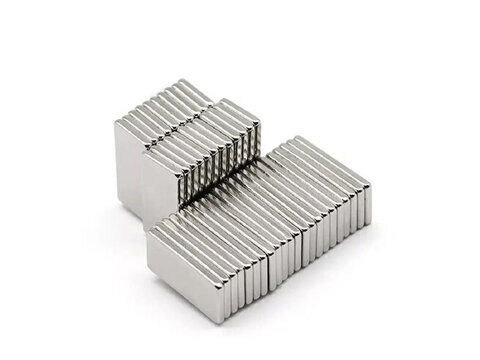
Permanent magnets are the most commonly encountered magnets in our everyday lives. They possess their magnetic properties naturally and retain their magnetism over time.
Permanent magnets are magnets that retain their magnetic properties over an extended period without the need for an external magnetic field. Unlike temporary magnets, which require external influences like electric currents or magnetic fields to exhibit magnetism, permanent magnets possess their inherent magnetic field.
Permanent magnets are magnets that retain their magnetic properties over an extended period without the need for an external magnetic field. Unlike temporary magnets, which require external influences like electric currents or magnetic fields to exhibit magnetism, permanent magnets possess their inherent magnetic field.
Permanent magnets have a high level of magnetization, meaning they possess a strong and consistent magnetic field. This property allows them to attract ferromagnetic materials like iron, nickel, and cobalt.
Permanent magnets generate a magnetic field that emanates from their poles. The magnetic field lines extend from the north pole to the south pole, creating an invisible force that interacts with other magnetic objects.
One key characteristic of permanent magnets is their ability to retain their magnetism over time. They can maintain a stable magnetic field without significant loss of strength or demagnetization, even in the presence of external factors like temperature changes or mechanical stress.
Coercivity refers to the resistance of a material to becoming demagnetized. Permanent magnets typically exhibit high coercivity, meaning it requires a significant external magnetic field or specific conditions to demagnetize them. This property ensures the longevity and reliability of permanent magnets in various applications.
Composition: Permanent magnets are made from specific materials that possess ferromagnetic properties. Common materials used in permanent magnets include Alnico (aluminum, nickel, cobalt), ceramic (ferrite), samarium-cobalt, and neodymium-iron-boron (neodymium) alloys. The composition of these materials determines the strength and performance of the magnets.
Permanent magnets are essential components in numerous technological applications, harnessing their inherent magnetic properties to provide functionality and efficiency. We will explore four common types of permanent magnets:

Alnico magnets are composed of aluminum, nickel, and cobalt, along with small amounts of iron and other elements. The name "Alnico" is derived from these primary constituents. They are known for their excellent temperature stability and high magnetic flux density. Alnico magnets can withstand high temperatures without significant loss of magnetic strength, making them suitable for applications in harsh environments. These magnets find extensive use in industries such as automotive, aerospace, and electrical engineering. They are commonly employed in loudspeakers, guitar pickups, sensors, and motors.

Ceramic magnets, also known as ferrite magnets, are economical and widely used due to their affordability and good magnetic properties. They are made from iron oxide (Fe3O4) blended with ceramic materials such as strontium or barium carbonate. Ceramic magnets possess a high coercivity, making them difficult to demagnetize. Their robustness and resistance to corrosion contribute to their popularity in various applications. Ceramic magnets are commonly found in refrigerator magnets, magnetic separators, DC motors, and magnetic resonance imaging (MRI) machines.

Samarium-cobalt (SmCo) magnets are known for their exceptional temperature stability and resistance to corrosion. They are composed of samarium and cobalt, along with small amounts of iron, copper, and other elements. SmCo magnets exhibit high magnetic strength and are capable of operating at elevated temperatures. These magnets find applications in environments where stability and reliability are crucial, such as aerospace, defense, and medical equipment. SmCo magnets are used in motors, sensors, magnetic couplings, and high-performance audio speakers.

Neodymium magnets also referred to as neodymium-iron-boron (NdFeB) magnets, are the most powerful permanent magnets commercially available. They consist of a mixture of neodymium, iron, and boron. Neodymium magnets possess extremely high magnetic strength and offer excellent performance in compact sizes. They have revolutionized numerous industries with their strong magnetic fields. Neodymium magnets are extensively used in electronics, automotive systems, renewable energy technologies, and consumer products. Applications include computer hard drives, headphones, electric vehicle motors, wind turbines, and magnetic closures.
Temporary magnets, also known as non-permanent magnets, are magnets that exhibit magnetism only under specific conditions or when influenced by external factors such as electric currents or magnetic fields. Unlike permanent magnets, temporary magnets do not retain their magnetism once the external influence is removed. Temporary magnets play an equally crucial role in various applications.
Temporary magnets can be magnetized and demagnetized at will, depending on the presence or absence of external factors. This property allows for dynamic control over their magnetic properties, making them highly versatile in various applications.
Temporary magnets generate a magnetic field only when the external influence is applied. Once the influence is removed, the magnetic field dissipates, and the material no longer exhibits magnetism. This limited duration of magnetism distinguishes temporary magnets from permanent magnets.
Temporary magnets can be magnetized and demagnetized repeatedly without significant loss of their magnetic properties. This reversibility makes them suitable for applications where magnetism needs to be adjusted or changed frequently.
The magnetism of temporary magnets relies on external factors such as electric currents or magnetic fields. They do not possess an inherent magnetic field and require these influences to induce magnetism. This characteristic allows for precise control and manipulation of the magnetic properties of temporary magnets.
The strength of the magnetic field exhibited by temporary magnets can be adjusted by altering the intensity of the external factors, such as the current flow or the strength of the magnetic field applied. This adjustability provides flexibility in meeting the specific requirements of different applications.
Temporary magnets are magnets that exhibit magnetism only under certain conditions or in the presence of external factors. In this section, we will explore different types of temporary magnets, highlighting their unique characteristics and applications. Understanding these types will provide insights into the diverse range of technologies that rely on temporary magnetism for functionality.
One of the most common and versatile types of temporary magnets is the electromagnet. Electromagnets are created by passing an electric current through a wire coil wrapped around a ferromagnetic core. The magnetic field generated by the current induces magnetism in the core, resulting in a strong magnetic field. The strength of the electromagnet's magnetic field can be controlled by adjusting the current flow. Once the current is switched off, the magnetism dissipates, and the electromagnet returns to its non-magnetic state.
Electromagnets have a wide range of applications due to their controllable magnetic properties. They are extensively used in electric motors, generators, relays, solenoids, magnetic resonance imaging (MRI) machines, magnetic cranes and lifts, speakers, and magnetic levitation (Maglev) trains. The ability to control and manipulate the magnetism of electromagnets makes them indispensable in these technologies.
Soft magnetic materials are another important type of temporary magnets. These materials, such as iron, nickel, and their alloys, can be easily magnetized and demagnetized when exposed to a magnetic field. Soft magnetic materials possess low coercivity, meaning they require minimal external magnetic fields to induce magnetism and can be readily demagnetized.
Soft magnetic materials are widely used in various industries due to their efficient magnetic flux induction and conduction. They are commonly found in transformers, inductors, magnetic shielding, electric motors, and generators. The ability to quickly respond to changes in magnetic fields makes soft magnetic materials ideal for applications where magnetic properties need to be adjusted rapidly.
Temporary magnetic materials are substances that exhibit magnetism under specific conditions or when influenced by external factors. These materials, such as certain types of ferromagnetic or paramagnetic materials, can be temporarily magnetized but lose their magnetism when the external factors are removed.
Temporary magnetic materials find applications in devices such as magnetic latches, magnetic closures, magnetic locks, and magnetic switches. These materials are employed in various industries, including electronics, automotive, aerospace, and security systems. The temporary magnetism of these materials allows for precise control and manipulation in specific applications.
Magnets play a vital role in numerous aspects of our lives, from everyday applications to cutting-edge technologies. We have explored permanent magnets such as alnico, ceramic, samarium-cobalt, and neodymium magnets, which provide long-lasting magnetism for a wide range of applications. Temporary magnets, including electromagnets, soft magnetic materials, and temporary magnetic materials, offer control and flexibility in magnetism. Superconducting magnets, on the other hand, harness the unique properties of superconducting materials to generate powerful magnetic fields.
By understanding the different types of magnets and their characteristics, we can appreciate their significance in various industries, including electronics, healthcare, transportation, and scientific research. Whether it's powering electric motors, enabling medical imaging, or advancing our understanding of fundamental physics, magnets continue to shape and enhance our technological advancements.
In conclusion, magnets have truly transformed our world, providing us with technological marvels, sustainable energy solutions, improved healthcare, and a deeper understanding of the universe. As we look ahead, the continued exploration and innovation in magnet technology will undoubtedly lead to even more exciting possibilities and advancements that will further enrich our lives.
Posted on September 30, 2025 by MagnetAdmin
Posted on October 14, 2024 by MagnetAdmin
Posted on July 12, 2024 by MagnetAdmin
Posted on June 07, 2024 by MagnetAdmin
Posted on October 10, 2023 by MagnetAdmin
Posted on August 07, 2023 by MagnetAdmin
Posted on July 06, 2023 by MagnetAdmin
Posted on October 10, 2023 by MagnetAdmin
Posted on June 27, 2023 by MagnetAdmin
Posted on September 19, 2023 by MagnetAdmin

